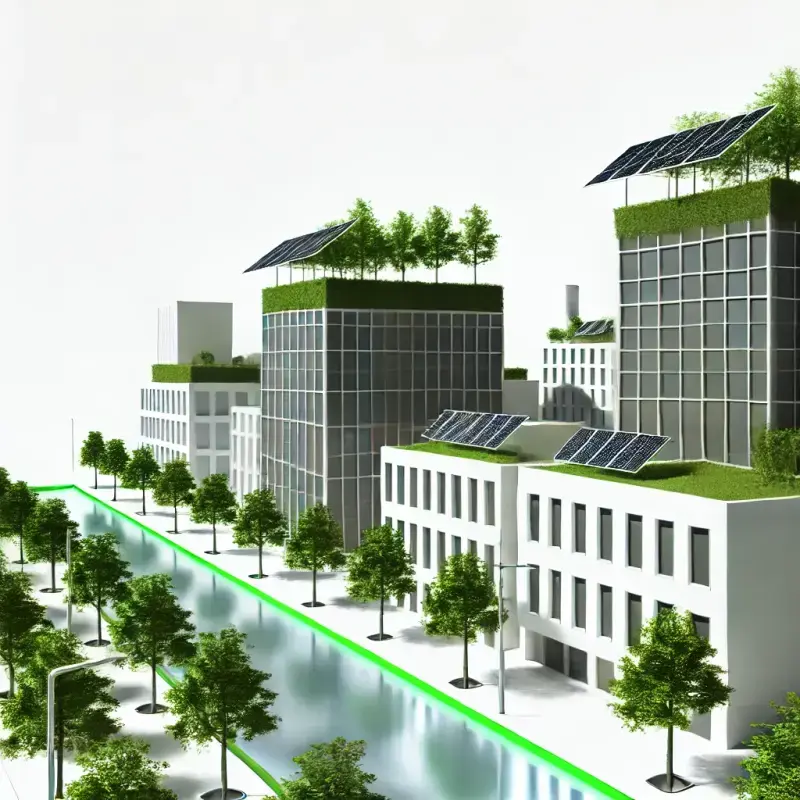Modern Solutions for Keeping Cities Cool: How Eco-Technologies Help Reduce Urban Heat
Cities around the world are facing rising temperatures due to a phenomenon known as the Urban Heat Island (UHI) effect. This occurs when urban areas become significantly warmer than surrounding rural areas, mainly because of human activities, heat-absorbing materials, and reduced vegetation. As global warming intensifies, the need for solutions to mitigate this effect becomes critical. Fortunately, eco-technologies are playing an increasingly important role in combating urban heat and preserving comfortable city environments. Below, we’ll explore some of the most promising modern technologies aimed at keeping our cities cool.

1. Green Roofs and Walls
One of the most effective ways to reduce urban temperatures is through the use of green roofs and green walls. These eco-friendly solutions involve planting vegetation on rooftops and walls, transforming otherwise heat-absorbing surfaces into cooling, oxygen-producing ecosystems.
How They Work: Plants on green roofs and walls absorb sunlight for photosynthesis, meaning less heat is trapped by the building surfaces. They also release moisture through a process called evapotranspiration, which cools the surrounding air. Additionally, green roofs provide insulation for buildings, reducing the need for air conditioning, which in turn lowers overall energy consumption and further helps in temperature regulation.
Benefits: Green roofs can lower rooftop temperatures by up to 40°C (104°F) on a hot day. They also improve air quality, enhance biodiversity, and contribute to stormwater management by absorbing rainwater.
2. Reflective and Cool Roofs
Another innovative approach to reducing heat absorption is through reflective or "cool" roofing materials. These surfaces are designed to reflect more sunlight and absorb less heat than standard roofing.
How They Work: Traditional building materials such as asphalt or dark-colored roofs absorb and trap heat, significantly raising building temperatures. Reflective roofing materials, on the other hand, are coated with materials that reflect a higher percentage of sunlight, helping to keep buildings and the surrounding environment cooler.
Benefits: Reflective roofs can reduce surface temperatures by up to 50°C (122°F) compared to conventional roofing. This translates into lower energy usage for cooling, reduced greenhouse gas emissions, and a more comfortable indoor environment.
3. Urban Tree Canopies and Green Spaces
Increasing the amount of greenery in urban areas is another crucial strategy for reducing temperatures. Trees, shrubs, and parks not only provide shade but also contribute to cooling through the process of transpiration.
How They Work: Trees and plants release moisture into the air, which cools the surroundings as it evaporates. Shade from trees also prevents heat from being absorbed by buildings, streets, and other urban structures. Large parks and green spaces act as natural cooling zones, counteracting the UHI effect in densely built areas.
Benefits: Cities with well-planned green spaces can see temperature reductions of several degrees Celsius, improving comfort for residents. Urban greenery also promotes better mental health, enhances social cohesion, and provides habitats for wildlife.
4. Permeable Pavements
Traditional concrete and asphalt pavements are notorious for absorbing heat during the day and releasing it at night, prolonging the heat retention of cities. Eco-friendly, permeable pavements offer a solution to this issue.
How They Work: Permeable pavements are designed to allow water to pass through them, which helps to cool the surface through evaporation. Additionally, the gaps in these pavements prevent the buildup of heat, making them a cooler alternative to conventional materials.
Benefits: These pavements not only reduce surface temperatures but also aid in managing stormwater by reducing runoff. This prevents flooding and helps recharge groundwater supplies, making them a sustainable option for urban planning.
5. Solar Shading and Cool Streets
Solar shading involves strategic placement of structures that provide shade to streets, sidewalks, and buildings. These can be simple awnings, solar panel canopies, or strategically planted trees. "Cool streets" refers to the use of lighter-colored or reflective materials for road surfaces, which absorb less heat.
How They Work: By providing shade or using materials that reflect sunlight, streets and pavements can remain significantly cooler. Solar panel canopies, in particular, offer a dual benefit: providing shade while generating clean energy.
Benefits: Solar shading and cool streets can reduce street-level temperatures by several degrees. They also make walking and cycling more comfortable, encouraging sustainable transportation options in cities.
Conclusion
As urban populations continue to grow, the challenge of maintaining comfortable and livable cities in the face of rising temperatures becomes increasingly pressing. Fortunately, eco-technologies like green roofs, reflective materials, permeable pavements, and urban tree canopies are offering innovative and effective solutions. By integrating these technologies into urban planning, cities can reduce the impact of the Urban Heat Island effect, creating cooler, healthier, and more sustainable environments for their inhabitants.
Eco-friendly urban cooling strategies not only help mitigate temperature spikes but also contribute to energy savings, better air quality, and improved quality of life. As more cities adopt these modern solutions, the future of urban living looks not only greener but cooler as well.
Articole
Abonați-vă la notificările noastre pentru a primi în mod regulat cele mai recente și mai interesante articole direct în căsuța de e-mail!